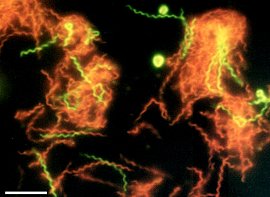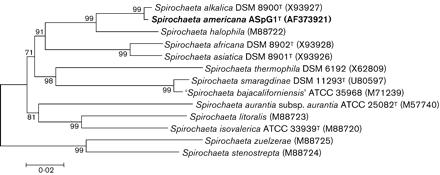Spirochaeta americana: Difference between revisions
| Line 21: | Line 21: | ||
==Cell Structure and Metabolism== | ==Cell Structure and Metabolism== | ||
==Ecology== | ==Ecology== | ||
Revision as of 06:00, 21 March 2008
Classification
Higher order taxa:
Domain Bacteria; Phylum Spirochetes; Class Spirochetes; Order Spirochaetales; Family Spirochaeta; Genus Spirochaeta; Species Spirochaeta americana
Description and Significance
S. americana is an extremophile. It has been found in the highly alkaline anaerobic environment of Mono Lake, California. S. Americana can also inhabit areas with high sulfur and salt concentrations. S. americana has scientists especially excited. Some believe that the harsh environment of Mono Lake is similar to that of Mars, giving hope to the theory that life existed there. [1, 2] S. americana is an obligate anaerobe and has an optimal pH range of 8.0 - 10.5. [2]Cells of the Gram-negative strain were motile and spirochaete-shaped with sizes of 0.2-0.22 x 8-18 microm.[3]
[1]
Genome Structure
A sequence covering 1467 nt of the 16S rRNA gene of Spirochaeta americana ASpG1T was obtained, corresponding to positions 28–1551 of the E. coli 16S rDNA sequence. The G+C content of this sequence was 55·96 mol%. The sequence was compared with all sequences presently available in the GenBank database and appeared to be highly similar to sequences from the spirochaete group of organisms.[3]
Cell Structure and Metabolism
Ecology
Isolation and Cultivation
Growth is dependent upon carbonate and sodium ions in the medium. No growth occurs below 2 % (w/v) NaCl or above 12 % (w/v) NaCl. Cells can be stored frozen in a liquid medium. Strictly anaerobic, catalase-negative chemoheterotroph with fermentative type of metabolism. Preferred substrates are D-glucose, fructose, maltose, sucrose, starch and D-mannitol. Requires vitamins and yeast extract for growth. Primary end product of glucose fermentation is H2; the minor end products in the stationary phase of growth are acetate, formate, ethanol and CO2. Resistant to kanamycin and rifampicin, but sensitive to gentamicin, tetracycline and chloramphenicol.[3]
References
1. http://science.nasa.gov/headlines/y2003/30jul_monolake.htm
2. http://www.scienceagogo.com/news/20030630213230data_trunc_sys.shtml
3.Spirochaeta americana sp. nov., a new haloalkaliphilic, obligately anaerobic spirochaete isolated from soda Mono Lake in California,(2003), Hoover RB, Pikuta EV, Bej AK, Marsic D, Whitman WB, Tang J, Krader P, Int J Syst Evol Microbiol,May;53(Pt 3):815-21


